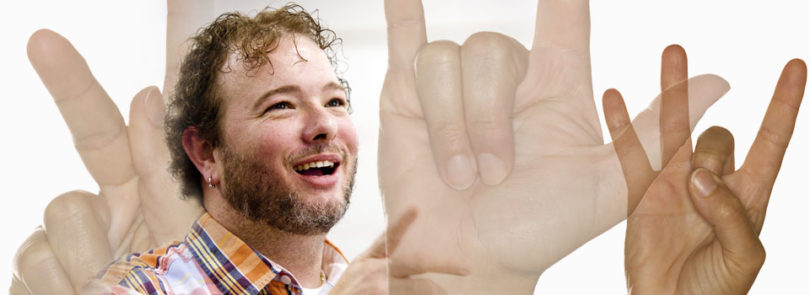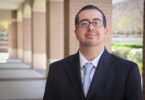Perhaps with the exception of final exams, you won’t find a quieter class on campus than the American Sign Language III course taught by Christopher Patterson, communication sciences and special education lecturer.
For a hearing person, the nearly completely silent class is a bit of a jolt.
“My first class (in ASL I) was awkward because it was so quiet,” said Adam Thielbar, a senior communication studies major. Thielbar is now in his third sign language class with Patterson.
At the same time, you’d be hard-pressed to find even an acting class more expressive than this one.
That’s because part of the key to effectively using sign language is to convey meaning not just with your hands but also with your face-really your entire body.
To an outside observer, the class sometimes seems like a game of charades, which isn’t entirely off base.
“What do you do when you’re a deaf person and you don’t know what to sign?” Patterson asked his class through signs. “You gesture.”
Through his sign language courses, Patterson, who is working on his doctorate in elementary education through the College of Education, is training students to be teachers able to help educate deaf or partially deaf children, to be sign language interpreters or to just be citizens able to communicate with and better understand the deaf community.
That matters to Patterson, in part, because he is deaf. He lost his hearing as an infant when he got spinal meningitis one week after being born prematurely.
Patterson’s upbringing in Albany and Tifton-with experiences running the gamut from very supportive grandparents to some frustrating school teachers-has informed his desire to improve education for deaf students.
In an interview assisted by Katie Wilson, a sign language interpreter in UGA’s Disability Resource Center, Patterson signed that he wanted to make the educational experience for young deaf children better than he had it in school.
“I grew up feeling like I wasn’t getting appropriate services,” he signed.
Through research, Patterson said he wants to study how deaf children acquire fluency in American Sign Language-in part to find best practices for teaching these children to communicate.
For now, Patterson seems to have success teaching hearing adults how to sign.
Sign language courses, as you might expect, operate a little like any foreign language course.
Instead of discouraging the use of English in the classroom, no talking is allowed in Patterson’s classes-hence the quiet classroom. That forces students to communicate with their hands, faces and bodies instead of their mouths.
“He (Patterson) will call you out,” said Samm Dyar, a junior international affairs major. “I have definitely been called out for speaking in class.”
Dyar, who describes herself as a “loud” person, said avoiding speaking has been difficult but learning the language has been worth it.
“I have fallen in love with the language-with the beauty of the language,” she said. “It’s very expressive. For me, it is very natural, because I’m a naturally expressive person.”
At the same time Patterson tries to teach his students how to learn the language, he also is trying to instill some of the culture of the deaf community.
In that arena, the classroom has its limitations.
“You have to go out and meet deaf people,” Patterson signed. “You have to go out and be immersed in it.”
To give students that exposure to the culture, Patterson requires students to participate in events in Athens that center around the deaf community.
One part of deaf culture that students are learning is that it is impolite to stare while someone is signing. What seems like a basic rule of etiquette is often broken, however.
“People don’t realize that deaf people don’t want to be stared at all of the time,” Patterson signed.
In addition to learning about deaf culture, Dyar said these assignments also are fun and bring students closer together.
Patterson’s classes have become quite popular-with waiting lists for ASL I classes. With ASL skills offering opportunities across fields, Patterson said he’s impressed by the variety of majors of students outside of the education college who take the course.
His goal is to see the program expanded at UGA to provide more ASL classes and, perhaps one day, a minor in deaf studies to include classes in deaf culture and history.
“I am hoping that UGA will have a reputation related to ASL,” he signed. “I’m really hoping our program just takes off.”






